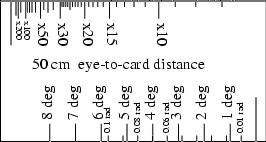
 |
This page has "business cards", which held at arm's length, help you measure angle, and thus to estimate distance and size. |
Example usage: Hold the card at arm's length, looking past it at a distant door. Tall people, and doors, are about 2 meters (yards) tall. If a distant door comes up to the x30 mark on the card, then then it is 2 times 30 meters away, so 60 meters. If it only comes up to the x50 mark, then it would be 2 x 50 = 100 meters away. Same with tall people. A short 1 meter (3 ft) person at x50 would be 1 x 50 = 50 meters away. A 3 or 4 meter high building floor at x20 would be (3 or 4) x 20 = (60 or 80) meters away.
|
An x30 door
|  |
A 2 yard high door, which appears to be "x30" high, is 2 x 30 = 60 yards away. |
Creating your card: Hold a piece of paper out at arm's length. Measure the distance from your eye to the paper. Print out the page closest to your distance. Chop it up into cards.
Mix.pdf (.ps)
30 cm (11.8 in)
(.ps)
35 cm (13.8 in)
(.ps)
40 cm (15.7 in)
(.ps)
45 cm (17.7 in)
(.ps)
50 cm (19.7 in)
(.ps)
55 cm (21.7 in)
(.ps)
60 cm (23.6 in)
(.ps)
65 cm (25.6 in)
(.ps)
70 cm (27.6 in)
(.ps)
75 cm (29.5 in)
(.ps)
Getting a feel for distance Go for a walk. Estimate the distance to houses, using their doors as above. Or instead of houses, you can use people, or posts, or cars, or anything else you know the size of. First just look at the house, and guess its distance. Then check your guess using the angle card. Then if you know the size of your stride, you can pace the distance to get another check. First start out by just trying to do "is it more like 1 meter, or 10 meters, or 100 meters?". Then as your accuracy improves with practice, you can try to get within 50%, 25%, etc. A good habit to practice is giving bounds on your estimate - "Well, I am sure it is more than xxx, and I am sure it is less than xxx,... and, well, my estimate is xxx.". Even if all you are sure about to start with is that it is more than nothing, and less than a zillion.
Measuring Angle and Distance with your Thumb has a few more examples.
Misc... You can carry the card around in your wallet, backpack, or even pocket. Printing on card-stock, rather than on paper, helps them last longer. Or you can just print out more, and treat them as disposable. A paper chopper helps save time when cutting out the cards. Or you can fold the paper, and run a scissor edge up inside. If a door is 2 meters tall, how tall is that house? How wide?
Thanks to a reader, Lamar Fussell, for motivating this page.
Notes:
The postscript is the hand-coded source. Feel free to fiddle.
Doables:
Next card draft:
Add url.
Drop ".5" from Mix - centering not worth silly precision.
Fine lines for x300+. Add rads to x side to show connection?
Use sin rather than small-angle-approx to place deg and rad ticks.
Do cleanup pass on source.
Would color be interesting? Allowing x, deg, and rad on same
side, showing connections? Or just have rules go in same direction?
Use clipping rather than conditional for degree inclusion.
So much more could be done with this page...
Discuss pacing back and forth to give a parallax baseline.
Gen card with ruler, (deg and rad) protractor.
What else could be done with this form factor? Reference data?
Having someone else hold the card at two-arms length, for greater accuracy.
Autogen cards with distance scale for known size targets (archery).
Search engine fodder: range finder, astrolabe, protractor.
History:
2002-Mar-05 Added `estimating Earth's diameter' note. Thanks to a reader.
2001-Nov-07 Added name to credit.
2001-Aug-14 Fleshed out. Online.
2001-Aug-12 Card postscript. Initial draft.